UNESCO World Heritage Site, Namhansanseong Fortress

Namhansanseong Fortress is a mountain fortress that was built in 1626, the fourth year of the reign of King Injo of the Joseon dynasty, on the former site of Jujangseong Fortress, which was built almost one thousand years earlier, in 672, during the reign of King Munmu of the Unified Silla dynasty.
The fortress was built twenty-five kilometers southeast of central Seoul to maximize its defensive position by taking advantage of rugged mountain terrain with an average altitude of over 480 meters above sea level. As the twelve kilometers of walls enclosed a wide, flat summit with sufficient space for a small town, Namhansanseong Fortress could be used as an emergency shelter for Joseon’s royal family and entourage in times of war.
Its design is based on the East Asian art of fortification, embodying aspects of the extensive cultural exchanges that took place between Korea (Joseon), Japan (Azuchi-Momoyama period), and China (Ming and Qing Dynasties) during the wars fought between the sixteenth and eighteenth centuries. During this period, European ideas about artillery were introduced to Korea, and the development of such weapons had a major impact on the construction of Namhansanseong Fortress.
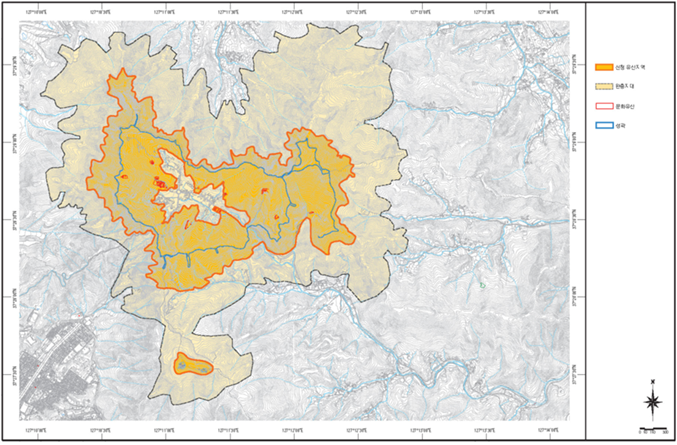
To be included on the World Heritage List, a site must have “outstanding universal value” (OUV) and meet at least one out of the ten (i to vi) selection criteria. The protection, management, authenticity, and integrity of cultural properties are also important considerations. Namhansanseong Fortress is a world heritage site that has outstanding universal value and satisfies criteria (ii) and (iv).
Selection criteria
A candidate for inclusion on the World Heritage List should exhibit evidence of “an important exchange of human values, over a span of time or within a cultural area of the world, on developments in architecture or technology, monumental arts, town-planning or landscape design.”
Namhansanseong is an excellent example that embodies the exchange of technological advances in fortress construction and weaponry in East Asia during a period of international conflict.
Namhansanseong is a unique fortress city built to serve as an emergency capital for Joseon’s royal family and to protect the nation’s sovereignty and independence.
A candidate for inclusion on the World Heritage List should be “an outstanding example of a type of building, architectural or technological ensemble or landscape which illustrates (a) significant stage(s) in human history.”
Namhansanseong’s walls and facilities were built to exploit the rugged local terrain, embodying the technological developments of fortress architecture accumulated in Korea from the seventh to the nineteenth century.
The original walls of Namhansanseong Fortress have been well preserved, and have a total length of 12.4 kilometers. Looking closely at the walls of Namhansanseong, it is clear that the types of stone and the methods used to build the various parts of the walls differ markedly. This indicates that Namhansanseong was not built in a single era, but was gradually expanded to its current form based on the vestiges of the former Jujangseong Fortress, which was built during the Unified Silla period. In this respect, the fortress is also an excellent example of a fortified structure that embodies the exchanges of technological advances in fortress construction and the development of weaponry that took place in East Asia during a lengthy period of international conflict, including the Qing invasion of Joseon (1636-1637). It is also a great case study for observation of the various phases in the development of fortification techniques from the seventh to the nineteenth century.
Unlike other fortresses, Namhansanseong enclosed a town and facilities for holding royal ancestral rituals. In the event of war or a national emergency, the king would leave the confines of Hanyangdoseong (Seoul City Wall) to take shelter in the temporary palace at the fortress, and the royal ancestral tablets would be moved from the Jongmyo Shrine to the Jwajeon Shrine at Namhansanseong, which played the role of a temporary capital of Joseon.
Authenticity
Namhansanseong has maintained its authenticity as a natural barrier, an architectural structure, and a township. Both fortress and town still retain historic components with regard to most aspects of authenticity, which are amply supported by various historical records. The specific attributes expressing the authenticity of the property are as follows.
In terms of form and design, Namhansanseong Fortress is a cross-valley type of structure, or pogoksik, consisting of a long oval shape extending from east to west. The fortress walls are approximately twelve kilometers in length, and the curved wall served to eliminate blind spots for its guns and artillery. The northern walls are considerably lower than the southern walls due to the uneven nature of the terrain. For defensive purposes, the outer wall was built at a higher point than the surrounding walls.
In terms of materials and substances, Namhansanseong was built with granite and gneiss, which can be found easily in the surrounding area. As for its parapets, it seems that they were built with grey bricks made from materials found in nearby areas.
In terms of tradition, techniques, and management system, Namhansanseong faithfully preserves the construction techniques of each different period, including the reigns of Kings Injo, Sukjong, Yeongjo and Jeongjo of the Joseon dynasty. The fortress was effectively managed under a three-tier system consisting of the commander of the Defense Command, the military temple system, and the three-military-division and two-shift system.
In terms of location and setting, as Namhansanseong is situated twenty-five kilometers away from Seoul, it was easy to escape from Joseon’s capital to the fortress, which could accommodate a large number of people. In addition, the Hangang River and the Gyeongancheon Stream functioned as a kind of natural moat, and there was easy access to water-borne transportation via the Hangang River. It was also a convenient transportation hub where Dongnae-ro and Bonghwa-ro intersected.
In terms of non-material tradition, the convenience of the local transportation network led to the development of folklore games such as torch fights, and the tradition of erecting guardian posts, among others, although it was also a conduit for epidemics. The area also served diverse purposes, for instance, as a center of traditional belief, including the Dodanggut Shamanistic Ritual performed at the Cheongnyangdang Shrine; as a symbolic place of the ruling Confucian ideology, including Bukbeollon (Policy of Northward Expansion – Qing and Uriankhai) after the Qing invasion of Joseon (1636-1637); and as a Catholic Church Martyrium (when it was used as Gwangju County Office). Furthermore, Namhansanseong preserves a variety of folkloric and cultural assets including a pine colony planted for the inhabitants and various local foods such as hyojonggaeng, a hangover soup of the Joseon period, and Sanseong soju, a traditional alcoholic beverage made with traditional taffy and local whole wheat.
In terms of spirit and emotion, throughout its long history, Korea has been invaded by many different countries. Namhansanseong is a historic place that played a pivotal role in resisting foreign powers and promoting the spirit of national independence. It was also a base of the righteous army that planned the advance on Seoul in the late Joseon period, and it was designated as Korea’s first National Park by the Syngman Rhee government. As a sacred place of national sovereignty, Namhansanseong still retains its military function to this day.
Integrity
The outstanding universal value (OUV) of Namhansanseong Fortress resides in the following three main components: military landscape, governance landscape, and folk landscape, all of which have been well maintained. With regard to the wholeness, intactness and risk-preparedness of the property, Namhansanseong fulfills all the requirements of integrity. First, the military landscape comprises the fortress walls, the military facilities of the command posts, the fortress gates, and the Buddhist military temples, all of which have been preserved intact and are repaired and maintained on a continuous basis, while only a small section of the wall near the East Gate was demolished by heavy rainfall in 1925.
Second, the governance landscape includes the Temporary Palace, Royal Ancestral Shrine, and Altar for the Deities of Earth and Grain, together with the local administrative facilities and the remaining sites of these facilities, all of which have been rebuilt, restored, or repaired. Third, the folk landscape comprises Confucian rituals, Buddhist rituals, traditional foods and liquors unique to Namhansanseong, as well as monuments, pavilions and the natural environment of the fortress. All these attributes of the folk landscape have been handed down from generation to generation, enhancing the intangible context of the heritage, and a plan for their preservation has been developed.
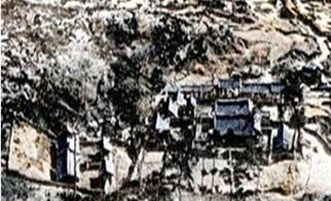
Temporary Palace at Namhansanseong Fortress in 1909

Present-day panoramic view of the Temporary Palace at Namhansanseong Fortress
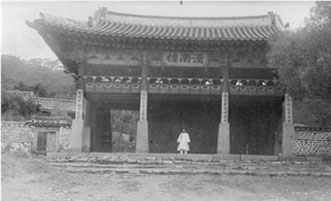
Hannamnu Gate Pavilion of the Temporary Palace at Namhansanseong Fortress in 1892
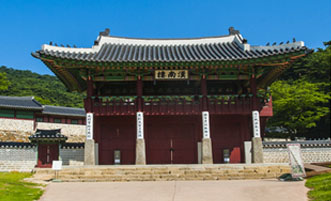
Present-day front view of Hannamnu Gate Pavilion of the Temporary Palace at Namhansanseong Fortress
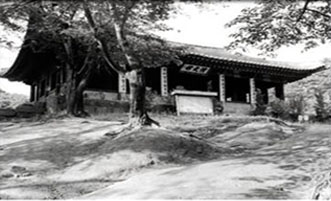
Yeonmugwan Pavilion in 1958

Present-day front view of Yeonmugwan Pavilion
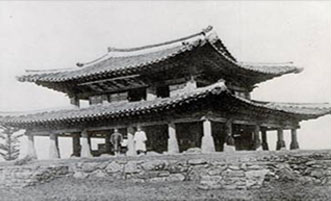
Sueojangdae Command Post in 1909
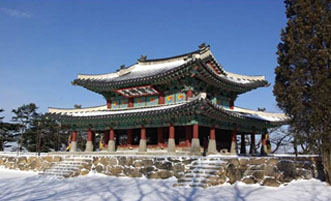
Present-day front view of the Sueojangdae Command Post
Scale of Namhansanseong Fortress
Scale of Namhansanseong Fortress
A table of the length of the castle provides information such as section, length (m), area (㎡), etc.
| Section |
Length (m) |
Area (㎡) |
| Main Fortress Wall |
7,545 |
2,126,637 |
| Outwork |
Namongseong Outwork No.1 |
426 |
2,381 |
| Namongseong Outwork No.2 |
318 |
3,583 |
| Namongseong Outwork No.3 |
125 |
839 |
| Janggyeongsa Sinjiongseong Outwork |
159 |
1,447 |
| Yeonjubongongseong Outwork |
315 |
865 |
| Sub-total |
8,888 |
2,135,752 |
| Bongamseong Fortress |
2,120 |
7,137 |
| Hanbongseong Fortress |
1,093 |
- |
| Sinnamseongdongdondae Post |
3,213 |
7,137 |
| Sinnamseongseodondae Post |
134 |
1,381 |
| Sub-total |
121 |
998 |
| Total |
255 |
2,379 |
※ The criteria for the Application for Namhansanseong’s Inscription on the World Heritage List (Feb. 2013)
※ The values may vary depending on the measurement.
Areas of the Namhansanseong World Heritage Site
Areas of the Namhansanseong World Heritage Site
A table of the area of the Namhansanseong World Heritage Area, providing information on the heritage area (Property Zone, Buffer Zone, total area, etc.)
| (Property Zone |
(Buffer Zone |
Total Area |
| 4,090,600 ㎡ (409.06 ha) |
8,537,100 ㎡ (853.71 ha) |
12,627,700 ㎡ (1,262.77 ha) |
※ The criteria for the Application for Namhansanseong’s Inscription on the World Heritage List (Feb. 2013)
※ The values may vary depending on the measurement.